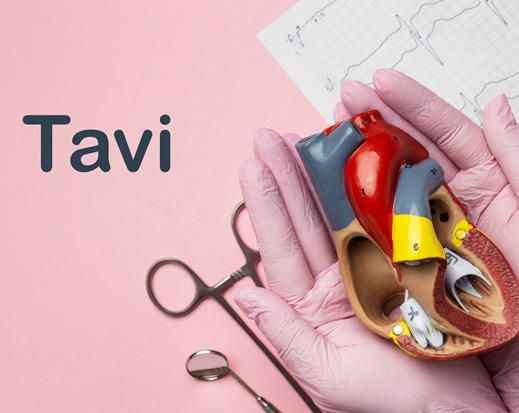



The aortic valve is located between the lower left compartment of the heart and the main artery of the body, and sometimes this valve may develop problems such as calcium buildup on the valve and become thicker. As a result, the valve cannot fully open, forcing the heart to work harder to pump blood through the damaged valve, which may lead to heart attacks or heart failure.
In order to solve the problem of aortic valve narrowing, we resort to replacing it (implantation) using a modern medical technique (transcatheter aortic valve implantation) (TAVI), a modern medical procedure that may be better than traditional methods (open heart operation), especially for older patients.
Aortic valve stenosis symptoms
1- Feeling faint
2- Tightness or chest pain
3- Fatigue
4- Heart palpitations
5- Quick heartbeat and flutter
Positions of insertion of catheters into the body
- Thigh: The most common method
- Armpits
- Aorta
Medical conditions not suited to them by ( TAVI)
1- Cardiac embolism
2- Stroke
3- Coronary Heart Disease
4- Presence of an infection
5- Blood germs
Medical conditions requiring a procedure (TAVI)
- Acute aortic valve tightness that causes symptoms such as chest pain and shortness of breath
- The valve is not fully open due to its increased thickness, resulting in reduced blood flow to the body
- Weak fabric aorta valve performance due to its damage
- Some health conditions, such as kidney or lung problems
- If the patient's state of health does not allow open heart surgery
Pre-operation preparations
- Inform the medical team of all the patient's medicines and supplements he takes
- Fasting for at least 6 hours before the procedure begins
- Stop drinking any fluids for two hours before the operation
- Conducting imaging and laboratory tests to assess the patient's condition before the procedure
Steps to perform aortic valve replacement (TAVI)
1- Most patients are given a local anesthetic
2- In rare cases, some patients may need general anesthesia
3- A small surgical incision is performed, and the doctor passes the catheter into one of the arteries in the groin
4- The catheter is directed to the heart and placed inside the aortic valve hole
5- The new valve is placed
6- The doctor removes the catheter and closes the wound
7- The procedure usually takes between one and two hours
Postoperative Guidance (TAVI)
1- Obligation to take prescription drugs as instructed
2- Take an anti-coagulant for 3 months
3- Avoid strenuous exercise or activities that require at least three days of effort or at the doctor's consultation.
4- Examine the position of the catheter daily for a week after the procedure, monitor signs of infection in the position of the wound, such as swelling and redness, and review with the doctor if it appears.
5- Keep a bandage on where the catheter was inserted for at least two days
6- Placing cold compresses on the area where the catheter was inserted to relieve pain or swelling
7- Taking enough rest
8- Eat a healthy diet
9- Drink plenty of water
Features Aortic Valve Replacement (TAVI)
- risk of infection because the procedure is done through a small incision of the body
- Healing time is less than conventional surgery
- Less blood loss than traditional methods (open heart surgery)
- Reduce complications of general anesthesia because the procedure is done with local anesthesia.
- Reduce symptoms resulting from aortic artery tightness, such as shortness of breath, dizziness, and fainting risk
- The procedure is suitable for patients over 75 years of age
- Reduce the risk of future heart failure.
- Most people return home a day or two after the procedure.
Complications (TAVI)
- Some side effects may occur if you do not comply with the doctor's instructions or if there are other heart problems, including:
- The risk of blood leakage between the surrogate valve and the heart wall, which increases the risk of valve infection (bacterial endocarditis),
- Bruising, bleeding, or infection at the catheter insertion site.
The procedure (TAVI) requires a fully equipped operating room and a full team with high technical skills of an interventional cardiologist, anesthetist, and specialist nursing team. In the hospitals of the Egypt HealthCare Authority, we provide a comprehensive assessment of each patient according to his/her health status and the best available modern techniques, and then we identify the best treatment plan to suit his/her needs. You can request a consultation from our medical staff in the Cardiovascular Disease Department of the Authority by visiting our health facilities or calling (15344).